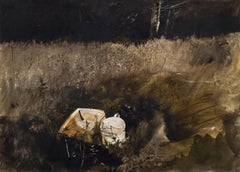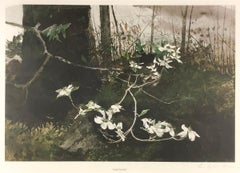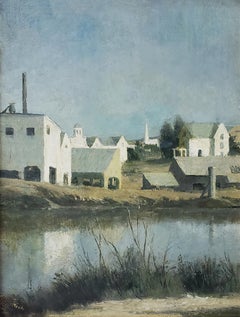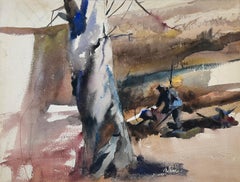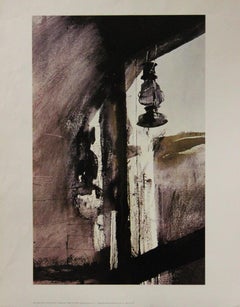Andrew Wyeth Art
American, 1917-2009
An artist who pursued his own course when the rest of the art world was consumed with modernism and abstraction, Wyeth is considered among the preeminent representational painters of the 20th century. Born in Chadds Ford, Pennsylvania, Wyeth drew his subject matter from the world around him: the interiors and exteriors of the stone buildings, mills, and farms of the Brandywine River countryside, and in the summers, the clapboard houses and stark landscape of the Maine coast. After his father died in a 1945 automobile accident, Wyeth began to incorporate people into his pictures, most notably Christina Olson, and later Siri Erickson, of Cushing, Maine, and his Chadds Ford neighbors Karl and Anna Kuerner and Helga Testorf. The first visual artist to appear on the cover of Time magazine, Wyeth was also the first living American-born artist to be given an exhibition at The Metropolitan Museum of Art in New York.
Wyeth’s naturalistic style is marked by strong editing combined with remarkable execution of details. While relying on keen visual observation, he pared down the elements of a composition to their most essential, giving his works an abstracted quality and imbuing them with a sense of quietude and stillness. The egg tempera medium (which he came to prefer to oil after first experimenting with it in the early 1940s) lent itself to the precise detailing required to create his subtle textural effects, since it dries quickly and translucent layers can be built up over one another. Wyeth also painted extensively in watercolor in works of more spontaneous execution, as well as in the drybrush technique (where most water is removed from the watercolor medium), sometimes combining the two.to
1
1
Overall Width
to
Overall Height
to
2
1
1
2
1
1
1
1
1
1
1
1
2
1
1
1
3
8,228
2,805
1,654
1,315
1
2
Artist: Andrew Wyeth
Quart and a Half
By Andrew Wyeth
Located in Palm Desert, CA
"Quart and a Half" is an American Realist abstract landscape watercolor on paper painting by Andrew Wyeth in 1961. The artwork is 21 x 29 1/4 inches and is 33 3/4 x 42 1/4 x 1 inches...
Category
20th Century American Realist Andrew Wyeth Art
Materials
Paper, Watercolor
Dogwood
By Andrew Wyeth
Located in Missouri, MO
Andrew Wyeth
"Dogwood" 1983
Collotype
Ed. 115/300
Signed and Numbered Lower Right
Image Size: 21 x 28 3/4 inches
Framed Size: approx. 29 x 36.5 inches
A painter of landscape and figure subjects in Pennsylvania and Maine, Andrew Wyeth became one of the best-known American painters of the 20th century. His style is both realistic and abstract, and he works primarily in tempera and watercolor, often using the drybrush technique.
He is the son of Newell Convers and Carolyn Bockius Wyeth of Chadds Ford, Pennsylvania, and was home-schooled because of delicate health. His art instruction came from his famous-illustrator father, who preached the tying of painting to life--to mood and to essences and to capturing the subtleties of changing light and shadows.
The Wyeth household was a lively place with much intellectual and social stimulation. Because of the prominence of N.C. Wyeth, persons including many dignitaries came from all over the country to visit the family. Andrew's sisters Carolyn and Henriette became noted artists as did his brother-in-law, Peter Hurd. The non-art oriented brother, Nathaniel Wyeth...
Category
1980s American Modern Andrew Wyeth Art
Materials
Paper, Lithograph
Price Upon Request
Related Items
Vermont Barns - Neutral Monochromatic Study in Grays
By John Koch
Located in Miami, FL
Understated town-scape in grays and muted blues. It's a painting that looks better as you get closer to it.
Koch brings the same serene intimacy to an outdoor scene as his interiors....
Category
1950s American Realist Andrew Wyeth Art
Materials
Oil, Board
Tower Afterglow - Original Lifeguard Tower Beach Painting
By Kathleen Keifer
Located in Los Angeles, CA
Kathleen Keifer is a California-based internationally collected artist. She is a leading force of the New California Realism. With a high level of technical virtuosity Keifer creates a new sense of reality with textures and colors that seem to add lighting effects and distinct shadows, confronting the viewer with new interpretations of familiar objects.
This one-of-a-kind 12 inch square original artwork is a composition created with acrylic paint on canvas. It is wired and ready to hang. The sides are painted as a continuation of the front and it does not require framing. It signed by the artist on the front of the artwork. Convenient local Los Angeles area shipping. Affordable Continental U.S. and global shipping also available. A certificate of authenticity issued by the art gallery is included.
Kathleen’s paintings invite the viewer to consider the complex relationship between time and timelessness. It is the sheer visual interaction between the elements, taken in their bare simplicity that interests her. For her, painting captures the very essence of time and its passage. She believes that actual sites and places have an individual magic. The goal is to take objects from popular culture and paint them in a new narrative context. Her complex approaches to popular board games present the subjects as living, tangible objects.
Born and raised in Chicago, Kathleen Keifer is a second-generation artist. Her mother, also a fine artist, exposed Keifer to the world of art and supervised her training from a very early age. This legacy continues today as Keifer closely nurtures the development of the artistic leaning in each of her three daughters, inspiring a third generation of female artists. Her works are represented by Artspace Warehouse Los Angeles and have been exhibited and collected internationally, including Chicago, New York and London.
Artspace Warehouse has been representing and exhibiting Kathleen Keifer's original artworks since 2017. The gallery has been a 1stdibs partner since 2014 with consistently excellent reviews from clients worldwide. The gallery exhibits a large selection of affordable original artworks from established and emerging international artists with diverse backgrounds at high standards. Artspace Warehouse is known to provide accurate descriptions, images, reliable services, communication, and delivery.
REPRESENTATION
Artspace Warehouse, Los Angeles, CA
EXHIBITIONS
2023 “Postcards From Nowhere”, Artspace Warehouse, Los Angeles, CA
2022 “The Comforting Familiar”, Artspace Warehouse, Los Angeles, CA
2020 “Midnight Blue”, Artspace Warehouse, Los Angeles, CA
2018 Morris Inn, Notre Dame, IN
Malibu Beach House, Malibu, CA
Bon Voyage, Coda Gallery, Palm Desert, CA
Solo Exhibition, Jeffrey Breslow Gallery, Chicago, IL
Art Palm Springs Fine Art Fair, CA
Artspace Warehouse, CA
2017 Affordable Art Fair New York, NY
Affordable Art Fair London, UK
Art Palm Springs, CA
“Pop Futurism and Abstraction”, Artspace Warehouse, Los Angeles, CA
2016 Susan Schomburg gallery, Santa Monica, CA
Jazz in the Pines, Idyllwild, CA
2015 Official artist of Chitag, Chicago Toy and Game Fair, Chicago, Il
Jazz! Dion Gallery, Redondo Beach, CA
Art 90266, LA 25, Manhattan Beach, C
Political Commentary, Linus gallery, Long Beach and Pasadena, CA
2014 RETROspective, Coast Gallery, Long Beach, CA
ArtHampton, Bridgehampton, NY
The Pursuit of…, Lurie Gallery, Los Angeles, CA
Art 90266, LA 25, Manhattan Beach, CA
2013 Pop meets Painterly, CODA Gallery, Palm Desert, CA
University of Notre Dame, Notre Dame, IN
Puzzles and Games, Liss Gallery, Toronto, Ontario, Canada
2012 Art, Wine & Roses, Home Gallery, Malibu, CA
Pop Meets Painterly, Oh My Godard Gallery, Atlantic City, NJ
2011 Beach Games, Riley Arts Gallery, Manhattan Beach, CA
Art of The Game, Oh My Godard Gallery, Atlantic City NJ
Art of The Game, Liss Gallery, Toronto, Ontario, Canada
2010 Art of The Game, Gallery 319, Santa Monica, CA
One Woman Show, Canfin Gallery, Westchester, NY
2009 American Riviera, ARTfront Gallery, Los Angeles, CA
American Landscape, Hilliard Gallery, Kansas City, MO
2008 Coastal Living, Gallery 319 Santa Monica, CA
2007 On the Beach, Gallery 319 Santa Monica, CA
Why We Live Here, Dion Gallery, Redondo Beach, CA
2006 Mc Lean Gallery, Malibu. CA
BOOK: Perspective on Coastal Beauty, From Malibu to Manhattan Beach
2005 Along the PCH, Mc Lean Gallery, Malibu, CA
FRESH!, MOCA, Los Angeles, CA
Gallery C, Hermosa Beach, CA
California Visions, Long Beach Museum of Art, Long Beach, CA
2004 President’s Show, CA Heritage Museum, Santa Monica, CA
Coastal Nostalgia, Mc Lean Gallery, Malibu, CA
Gallery C, Hermosa Beach, CA
2003 Los Angeles County Museum of Art, Los Angeles, CA
Coastal Nostalgia, 2003, Mc Lean Gallery, Malibu, CA
2002 Coastal Nostalgia, 2002, Mc Lean Gallery, Malibu, CA
2001 Los Angeles County Museum of Art, Los Angeles, CA
Ambient Light, Mc Lean Gallery, Malibu, CA
2000 The Coastal Landscape, Mc Lean Gallery, Malibu, CA
Malibu Art...
Category
21st Century and Contemporary American Realist Andrew Wyeth Art
Materials
Canvas, Acrylic
Royal Hotel - New Orleans 1920s Depression Art Lithograph in Ink on Paper
Located in Soquel, CA
Royal Hotel - New Orleans 1920s Depression Art Lithograph in Ink on Paper
Dramatic street scene with a man wearing a trench coat and hat by Robert J We...
Category
Late 20th Century American Modern Andrew Wyeth Art
Materials
Paper, Lithograph
$975
H 20 in W 16 in D 0.25 in
Prodigal Son
By Thomas Hart Benton
Located in London, GB
A man raises his hand to his chin, his neck tilted and face turned to look at a dilapidated farmhouse, barely held together by planks of wood and exposed to the elements. Behind him ...
Category
1930s American Modern Andrew Wyeth Art
Materials
Lithograph
Pastel Diagonal Tiled Floor, Abstract Sun Shapes, Pink, Yellow and Red Triangles
By Natalia Roman
Located in Barcelona, ES
These series of paintings by Natalia Roman gather their inspiration from geometric, minimalist shapes and paintings from the beginning of Modernism, with a special emphasis on Art De...
Category
2010s Abstract Geometric Andrew Wyeth Art
Materials
Oil, Acrylic, Watercolor, Paper
November Garden
By Gail Chase-Bien
Located in Burlingame, CA
Gail Chase Bien paints thinly layered oil on linen over extended periods (from months to years) to complete a single work of art. Taking cues from nature’s extraordinary visual offer...
Category
21st Century and Contemporary American Realist Andrew Wyeth Art
Materials
Canvas, Oil
Evening in The Tropics, Geometric Tiles in Yellow, Miami Sunset Patterns
By Natalia Roman
Located in Barcelona, ES
These series of paintings by Natalia Roman gather their inspiration from geometric, minimalist shapes and paintings from the beginning of Modernism, with a special emphasis on Art De...
Category
2010s Abstract Geometric Andrew Wyeth Art
Materials
Watercolor, Acrylic, Rag Paper
Cat and Busybody
By Benton Murdoch Spruance
Located in Middletown, NY
A 1933 lithograph on cream wove paper 14 x 18 inches (354 x 452mm), full margins. Signed, titled, and numbered 17/33 in pencil, lower margin. Minor mat tone around the perimeter of t...
Category
1930s American Modern Andrew Wyeth Art
Materials
Lithograph
"Factory on the River" Modernist and Precisionist WPA Industrial New York Scene
By William Sharp
Located in New York, NY
William Sharp (1900 - 1961)
Factory on the River
Oil on canvas
17 1/2 x 23 1/4 inches
Initialed lower right: WS
Provenance:
Estate of the artist
Private Collection, New York
Swann Auction Galleries, American Art, June 13, 2019, Lot 178
William Sharp was born on June 13, 1900, in Lemberg, Austria, where he attended college and the Academy for Arts and Industry. He later studied in Kraków, Poland, and in Berlin and Munich, Germany. Sharp began his career as a designer of stained-glass windows and as a painter of murals. He served in the German army during World War I. After the war he became a newspaper artist in Berlin and a well-known etcher.
Sharp drew political cartoons that were bitterly critical of the growing Nazi movement. As the influence of National Socialism intensified, he began to contribute drawings, under a pseudonym, to publications that were hostile to Hitler. After Hitler assumed power, Sharp was confronted with these drawings and told that he would be sent to a concentration camp. However, in 1934, he escaped to the United States.
His first newspaper assignment in America was making courtroom sketches for The New York Mirror...
Category
Mid-20th Century American Realist Andrew Wyeth Art
Materials
Canvas, Paint, Oil
$5,600 Sale Price
20% Off
H 17.5 in W 23.25 in
1930s Black and White Lithograph of House at Gregory Point, Colorado Landscape
By Arnold Rönnebeck
Located in Denver, CO
This original lithograph by renowned modernist Arnold Ronnebeck (1885-1947) depicts a charming home in Gregory Point, near Central City, Colorado. Created during the 1930s, this piec...
Category
1930s American Modern Andrew Wyeth Art
Materials
Paper, Lithograph
Arnold Rönnebeck1930s Black and White Lithograph of House at Gregory Point, Colorado Landscape, 1937
$1,250
H 23.25 in W 18.5 in D 1.5 in
Down the River
By Thomas Hart Benton
Located in London, GB
In this sentimental work from 1939, Benton expresses his admiration for the rural lifestyle of the Midwest. He highlights the connection between man and the land by depicting two fig...
Category
1930s American Modern Andrew Wyeth Art
Materials
Lithograph
Acropolis Americana - Lincoln Center, New York 1975
By Gerald Geerlings
Located in Middletown, NY
Zinc lithograph on cream wove paper, 12 3/4 x 10 inches (272 x 253 mm), full margins. Signed and titled in pencil, lower margin. One work from the series titled "Salute to New York,"...
Category
20th Century American Modern Andrew Wyeth Art
Materials
Handmade Paper, Lithograph
Previously Available Items
Beech Tree, Watercolor Landscape by Chadds Ford Artist Andrew Wyeth
By Andrew Wyeth
Located in Doylestown, PA
Beech Tree is a watercolor and pencil on paper landscape and figurative work by American painter Andrew Wyeth. The 21 3/4 x 29 1/8 inches work is framed and matted behind museum glas...
Category
1930s American Realist Andrew Wyeth Art
Materials
Watercolor, Archival Paper, Pencil
H 32 in W 40.25 in D 2 in
Split Ash Basket, Karl's Room, The Scarecrow, The Fortune, Shed Lantern, Bundle
By Andrew Wyeth
Located in Chesterfield, MI
Bulk Sale of nine posters
Dimensions for packaging: two tubes measuring 43 in x 4 in - two shipping labels needed (1/1 and 1/2)
Category
20th Century Andrew Wyeth Art
Materials
Lithograph
Master Bedroom-Framed Lithograph
By Andrew Wyeth
Located in Chesterfield, MI
Reproduction of "Master Bedroom" by Andrew Wyeth. Measures 28.5 x 35.5 x 1.25 inches with frame and matting. Image is in Excellent Condition. Framing has cosmetic imperfections (i.e....
Category
Late 20th Century Andrew Wyeth Art
Materials
Lithograph
ANDREW WYETH Dusk 31.75" x 23.75" Offset Lithograph Contemporary Black & White
By Andrew Wyeth
Located in Brooklyn, NY
"Dusk" by Andrew Wyeth, Unsigned Offset Lithograph poster. The overall size of the Offset Lithograph is 31.75 x 23.75 inches. The condition of this piece has been graded as A-: Nea...
Category
21st Century and Contemporary Andrew Wyeth Art
Materials
Lithograph, Offset
"Dogwood, " Andrew Wyeth, Flowers in the Forest Woods
By Andrew Wyeth
Located in New York, NY
Andrew Newell Wyeth (1917 - 2009)
Dogwood 1983 HS, 1983
Collotype on paper
16 x 24 inches
Edition 208/300
Signed lower right
A painter of landscape and figure subjects in Pennsylvania and Maine, Andrew Wyeth became one of the best-known American painters of the 20th century. His style is both realistic and abstract, and he works primarily in tempera and watercolor, often using the drybrush technique.
He is the son of Newell Convers and Carolyn Bockius Wyeth of Chadds Ford, Pennsylvania, and was home-schooled because of delicate health. His art instruction came from his famous-illustrator father, who preached the tying of painting to life--to mood and to essences and to capturing the subtleties of changing light and shadows.
The Wyeth household was a lively place with much intellectual and social stimulation. Because of the prominence of N.C. Wyeth, persons including many dignitaries came from all over the country to visit the family. Andrew's sisters Carolyn and Henriette became noted artists as did his brother-in-law, Peter Hurd. The non-art oriented brother, Nathaniel Wyeth...
Category
1980s American Modern Andrew Wyeth Art
Materials
Paper, Lithograph
"The Quaker, " Andrew Wyeth Interior Clothing Still Life
By Andrew Wyeth
Located in New York, NY
Andrew Wyeth (1917 - 2009)
The Quaker, 1976
Collotype on paperboard
22 1/2 x 24 1/2 inches
Framed in original frame as issued by the Metroploitan Museum of...
Category
1970s American Modern Andrew Wyeth Art
Materials
Paper, Board, Lithograph
"Dog on Bed, " Giclee Print by Andrew Wyeth
By Andrew Wyeth
Located in Milwaukee, WI
"Dog on Bed" is a Giclee Print by Andrew Wyeth. This print shows a golden retriever cuddled up by the pillows at the top of the bed in a large queen. The bed has a white duvet with l...
Category
Mid-20th Century Realist Andrew Wyeth Art
Materials
Giclée
"Storing Up" Organic Abstract Print from the Collection Of Mrs. Andrew Wyeth
By Andrew Wyeth
Located in Houston, TX
Abstract lithograph of two organic shapes with textures of wood and scales. The work is stamped with the title and date. The lithograph is after the original dry brush work. It also ...
Category
1950s Surrealist Andrew Wyeth Art
Materials
Lithograph
H 13.5 in W 17 in D 0.004 in
Vintage Andrew Wyeth Abrams Art Print Americana Offset Lithograph from Holland
By Andrew Wyeth
Located in Surfside, FL
This is a vintage offset lithograph from an edition printed in Holland by Smeets Weert for Abrams Press. It is titled Ground Hog Day. it is an oil painting that is in the collection of the Philadelphia Museum of Art.
Andrew Wyeth was born in Chadds Ford in 1917, the fifth child of artist NC Wyeth...
Category
1950s American Realist Andrew Wyeth Art
Materials
Color
Rare Andrew Wyeth 1956 Collotype Print from Signed Edition Americana Artwork
By Andrew Wyeth
Located in Surfside, FL
This is a rare 1956 original collotype from the signed portfolio published by Triton Press. These were selected by A. N. Wyeth himself. The works are not individually signed and numb...
Category
1950s American Realist Andrew Wyeth Art
Materials
Color
Rare Andrew Wyeth 1956 Collotype Print from Signed Edition Americana Artwork
By Andrew Wyeth
Located in Surfside, FL
This is a rare 1956 original collotype from the signed portfolio published by Triton Press. These were selected by A. N. Wyeth himself. The works are not individually signed and numb...
Category
1950s American Realist Andrew Wyeth Art
Materials
Color
"The Lobster Man"
By Andrew Wyeth
Located in Lambertville, NJ
Jim’s of Lambertville is proud to offer this artwork.
Signed lower right
Period Newcomb Macklin frame
Andrew Newell Wyeth (1917 - 2009)
A painter known for his landscape and figu...
Category
20th Century American Realist Andrew Wyeth Art
Materials
Watercolor, Paper
Andrew Wyeth art for sale on 1stDibs.
Find a wide variety of authentic Andrew Wyeth art available for sale on 1stDibs. Not every interior allows for large Andrew Wyeth art, so small editions measuring 37 inches across are available. Customers who are interested in this artist might also find the work of Virgil Trasher, Luigi Lucioni, and Millard Sheets.
Artists Similar to Andrew Wyeth
Questions About Andrew Wyeth Art
- 1stDibs ExpertApril 5, 2022American artist Andrew Wyeth was best known as a realist painter, although he did incorporate some regionalism and modern art into his works as well. Born in Pennsylvania, his favorite subjects were the land and people around him in that state and his summer home state of Maine. On 1stDibs, find a variety of original artwork from top artists.
- 1stDibs ExpertFebruary 22, 2021An Andrew Wyeth painting can be worth anywhere from $200 to over $80 million. 1stDibs.com sells a number of paintings from Andrew Wyeth.
- 1stDibs ExpertFebruary 7, 2024You can find Andrew Wyeth paintings in many art institutions. This includes the collections of museums like the Metropolitan Museum of Art in New York; the Farnsworth Museum in Rockland, Maine; the Philadelphia Museum of Art and the Smithsonian American Art Museum in Washington, D.C. Select works are also available through galleries, auction houses and trusted online platforms. Shop a range of Andrew Wyeth art on 1stDibs.
